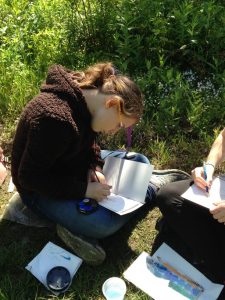
Observing and painting bluets
Hogback Field Day with Marlboro Elementary School, June 9th 2017
Facilitators & Authors: Jenny Ramstetter, Cathy Osman & Liza Mitrofanova, Marlboro College
Observation is central to both the sciences and the arts. It allows us to enter a space where we can gather data, insight, and inspiration. It lays groundwork for experiments. Sometimes questions guide observation, other times observations unearth questions, and most often, the two feed each other in a loop.
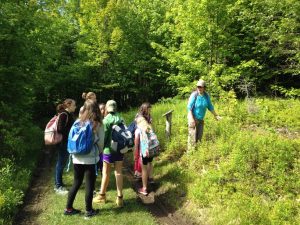
Jenny points out nest of thatching ants
We had two hours with a group of mixed age students from 3rd-7th grade on a retired ski mountain called Hogback. After gathering our group, we walked along the main trail, attempting to set a norm of stopping often and taking notice of our surroundings. We pointed out the bedrock, the way its surface differed from highly trafficked areas to places off trail. We knelt down to inspect scat, coming to a collective conclusion that it must have come from a medium sized predator, such as a coyote or a fox. From this perspective, the students noticed a sizable spider carrying what older students identified as an egg sac. We came upon a nest of thatching ants, sprinklings of bluets, and ruts made by tire tracks which now serve as channels for water and a hatching ground for bugs. These stops and notes all served to help prime students for considering relationships and to think about what site or organism they may want to choose for close observation.
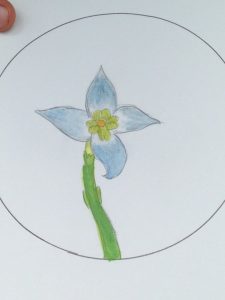
Bluet zoom-in
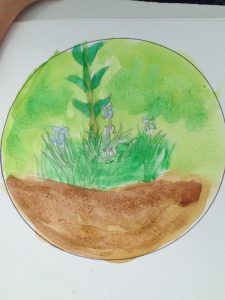
Bluet 1 ft view
After arriving at the first opening in the trail, giving us a short view up and down the mountain, we gathered and explained the close observation exercise. The journals had been prepared the night before with 3 circles of a 3” diameter drawn on the first three pages of the journal, leaving space for notes. These circles serve as frames or lenses for the view/drawing of the chosen site. The first circle is meant for a zoomed-in, detail view of an organism or site, the second a 1 foot away description, and the third a more zoomed out view. For older students this 3rd circle could be a 2ft away description, and another page could serve as a full page drawing.
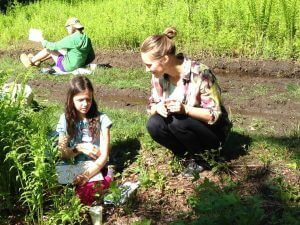
Liza checks in with each student
We reminded students to pay attention to texture, shape, color, and relationships between different elements of their drawings. We also asked students to write down any questions that arose about their site: “What do you want to know about your site?” “What clues can you find to help answer these questions?”
After students completed their 2nd drawings, we gathered again to share drawings, questions, and observations. Bluets and ferns were the most popular subjects, but red maple samaras, maple leaves, and water washing over pebbles were not overlooked. Students asked “why are bluets blue?” “Why don’t bluets have leaves?” “How did the water place these pebbles so perfectly?” “Why are samaras so full of veins?” “What makes samaras so red?” “Why do bluets grow where they grow?”

Fern close-up
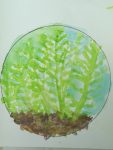
Fern 1 ft view
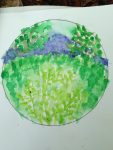
Fern zoom out
After sharing and talking as a group, the students had a chance to start another drawing. With more time or another session, it would be interesting to see if the discussion produced any change in drawing styles or questions generated. Some of the students struggled with being asked to complete a second drawing of the same subject, feeling bored or influenced by drawings other students were doing. Drawing the zoomed in and zoomed out perspectives can be powerful tools in creating awareness of the relationships of individual organism has with its surrounding community and environment. We gently encouraged our students to persevere through their second drawing of the same subject, with the promise that their third drawing could be of anything else that caught their eye from a perspective of their choice. The handmade journals full of the mornings’ watercolors were sweet gifts for the students to walk away with at the end of the activity.
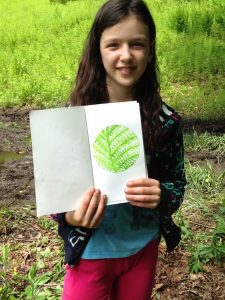
Artist with journal
Materials for Activity: Watercolors, brushes, plastics cups for water, paper towels, pencils, large water container, 1.5×1.5” sheets of plastic (to sit on in case of wet ground and mud), journals with about 8 pages for drawing and notes
Hogback Mountain Conservation Area is the headwaters for important tributaries of the Connecticut River and a source of inspiration for place-based education. Marlboro Elementary School’s annual field day at Hogback Mountain features activities like Art & Ecology, designed by teachers and community members to strengthen children’s connections to their local environment. For more information, please visit Hogback Mountain and Marlboro Elementary School.







